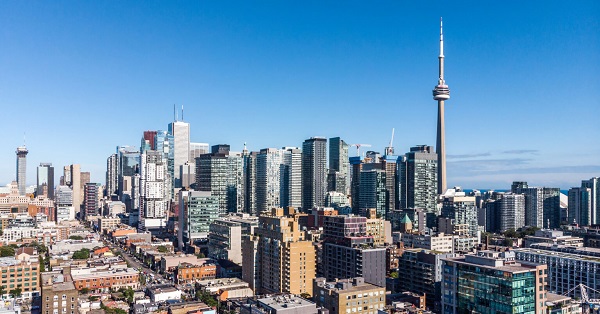Aristotle Foundation
Canada’s immigration system and Islamist terror threats

From the Aristotle Foundation for Public Policy
By Collin May
Arrests linked to terrorism reveal concerns over both imported and homegrown radicalization
Recently, Canada’s immigration system has come under scrutiny due to a series of arrests of individuals alleged to be planning terrorist attacks. The first arrests came in July when a father and son, Ahmed Fouad Mostafa Eldidi and Mostafa Eldidi, were charged with a number of terrorism-related offenses after their arrest near Toronto. The pair immigrated to Canada, where the father obtained his citizenship, prompting a review of immigration screening processes.
This was followed earlier this month by the arrest of Muhammad Shahzeb Khan, who was alleged to be planning a mass shooting at a Jewish center in New York City. Kahn, a Pakistani citizen, was in Canada on a student visa. He was arrested in Quebec on his way to New York.
While these two cases playing out in eastern Canada have drawn the most media attention, we need to look to western Canada, specifically to the province of Alberta, to find several examples of homegrown Canadian terrorism. Earlier this month, Zakarya Rida Hussein, a Canadian citizen living in Calgary, Alberta, was sentenced to six years in prison on terrorism-related charges, including plans to bomb Calgary’s Pride Parade in 2023.
Even more problematic for Canada’s international reputation were two Alberta residents exporting Islamist terrorism to the United Kingdom and Israel. In July of this year, a London jury found Anjem Choudary, the notorious leader of the radical Al-Muhajiroun group, guilty of directing a terrorist group. However, Choudary was not alone in the dock. Khaled Hussein, originally from Edmonton, Alberta, was also convicted of holding membership in the same banned terror organization.
Similarly, in Israel, radicalized Alberta teacher Zachareah Adam Quraishi was killed earlier this summer when he attempted to attack an Israeli security post at Netiv Ha’asara. Quraishi was educated at the University of Alberta.
These incidents suggest a growing problem as it relates to both the importation of terrorists into Canada and the radicalization of Canadian Muslim citizens with the added concern that Canada is now exporting Islamist terror to our allies in the US, Europe, and Israel. This raises the question of what Canadian governments, at the national and provincial level, are doing to counter the importation and domestic growth of terror.
Immigration is primarily a federal responsibility, and opposition Conservative deputy leader Melissa Lantsman has been attempting to hold the Canadian government’s feet to the fire. Over the past few months, Lantsman has been demanding answers as to how the father-son duo was able to immigrate to Canada, and why a student visa was issued to Khan, allowing him to use Canada as a staging ground for attacks in New York.
In terms of the domestic radicalization of Canadian citizens in the province of Alberta, there has been little discussion regarding how this is occurring or what the federal and provincial governments are doing to stem the tide. In Canada, for instance, education is a provincial responsibility, but nothing has been said by the conservative Alberta government about the proliferation of Islamist ideologies in the province or if anything is being done through the education system to counter their impact.
This silence is coming at a time when Canada’s federally-appointed special representative on combating Islamophobia, Amira Elghawaby, recently sent a letter to college and university administrators in Canada recommending the hiring of more Muslim, Arab, and Palestinian professors. Far from expressing concern over the growing Islamist terror threats emanating from Canada, Elghawaby highlighted an alleged dangerous climate on Canadian campuses for pro-Palestinian protesters.
The province of Quebec, no friend of Elghawaby, called for the federal Islamophobia representative to resign, citing her interference with Quebec’s provincial jurisdiction and its stance that academic hiring in the province should be based on principles of secularism rather than religious affiliation. No such call has come from the Alberta government.
That the Alberta government has had nothing to say on these matters should not surprise Canadians given that Alberta’s minister responsible for advanced education, Rajan Sawhney, was the only member of the Alberta provincial government to publicly call for my own resignation as chief of the Alberta Human Rights Commission in 2022.
My crime, in Sawhney’s eyes, was having written an academic review of a book on historic Islamic imperialism penned by renowned British-Israeli historian Efraim Karsh and published by Yale University Press in 2006. Ms. Sawhney’s initial statement condemning my review has since been removed from her Facebook page.
To date, there is little evidence that most Canadian governments, federally or provincially, are overly concerned about Canada’s new reputation, and especially that of Alberta, as exporters of Islamist terrorism. However, as governments grapple with the potential negative blow-back from our allies, this attitude may undergo a rather abrupt change.
Collin May is a lawyer in Calgary, a senior fellow with the Aristotle Foundation for Public Policy, an adjunct lecturer in community health sciences at the University of Calgary, a former chief of the Alberta Human Rights Commission, and the author of numerous articles on the psychology, philosophy, and social theory of cancel culture.
Aristotle Foundation
Canada has the world’s MOST relaxed gender policy for minors

Are Canada and the United States out-of-step on gender policy for minors?
READ the new study by the Aristotle Foundation and Do No Harm: https://aristotlefoundation.org/study…
|
Alberta
On gender, Alberta is following the science

Despite falling into disrepute in recent years, “follow the science” remains our best shot at getting at the truth of the physical sciences.
But science, if we are to place our trust in it, must be properly defined and understood; it is at its essence an ever-changing process, a relentless pursuit of truth that is never “settled,” and one that is unafraid to discard old hypotheses in the face of new evidence.
And it is in this light—in the unforgiving glare of honest science—that Alberta Premier Danielle Smith’s three new legislative initiatives around gender policy are properly understood, notwithstanding the opprobrium they’ve attracted from critics.
Bill 26, the Health Statutes Amendment Act, proposes to prohibit the prescription of puberty blockers and cross-gender hormones for the treatment of gender dysphoria to youth aged 15 and under. It would allow minors aged 16 and 17 to begin puberty blockers and hormone therapies for gender “reassignment” and “affirmation” purposes only with parental, physician, and psychologist approval. The bill also prohibits health professionals from performing sex reassignment surgeries on minors.
Bill 27, the Education Amendment Act, seeks to enshrine parents’ rights to be notified if their kids change their names/pronouns at school, and it gives parents the right to “opt in” to what sort of gender and sex education their kids are exposed to in school.
And Bill 29, the Fairness and Safety in Sports Act, is designed to protect females in sports by ensuring that women and girls can compete in biological female-only divisions, while supporting the formation of co-ed opportunities to support transgender athletes.
Each of these initiatives is entirely reasonable, given what we know of the science underpinning “gender care,” and of the undeniable advantages that a male physique confers upon biological males competing in sports.
The notion that the trifecta of puberty blockers, cross-gender hormones, and revisionist surgery is a pathway to good health was a hypothesis initially devised by Dutch researchers, who were looking to ease the discomfort of transgender adults struggling with incongruence between their physical appearance and their gender identities. As a hypothesis, it was perhaps reasonable.
But as the UK’s Cass Review exposed in withering detail last spring, its premises were wholly unsupported by evidence, and its implementation has caused grievous harm for youth. As Finnish psychiatrist Riittakerttu Kaltiala, one of the architects of that country’s gender program, put it last year, “Gender affirming care is dangerous. I know, because I helped pioneer it.”
It’s no accident, then, that numerous European jurisdictions have pulled back from the “gender affirming care” pathway for youth, such as Sweden, Finland, Belgium, the Netherlands, and the United Kingdom.
It makes perfect sense that Canadians should be cautious as well, and that parents should be apprised if their children are being exposed to these theories at school and informed if their kids are caught up in their premises.
Yet the Canadian medical establishment has remained curiously intransigent on this issue, continuing to insist that the drug-and-surgery-based gender-affirming care model is rooted in evidence.
Premier Smith was asked by a reporter last month whether decisions on these matters aren’t best left to discussions between doctors and their patients; to which she replied:
“I would say doctors aren’t always right.”
Which is rather an understatement, as anyone familiar with the opioid drug crisis can attest, or as anyone acquainted with the darker corners of medical history knows: the frontal lobotomy saga, the thalidomide catastrophe, and the “recovered memories of sexual abuse” scandal are just a few examples of where doctors didn’t “get it right.”
As physicians, we advocate strongly for self-regulation and for the principle that medical decisions are private matters between physicians and patients. But self-regulation isn’t infallible, and when it fails it can be very much in the interests of the public—and especially of patients—for others to intervene, whether they be journalists, lawyers, or political leaders.
The trans discussion shouldn’t be a partisan issue, although it certainly has become one in Canada. It’s worth noting that Britain’s freshly elected Labour Party chose to carry on with the cautious approach adopted by the preceding administration in light of the Cass Review.
Premier Smith’s new polices are eminently sensible and in line with the stance taken by our European colleagues. None of her initiatives are “anti-trans.” Instead, they are pro-child, pro-women, and pro-athlete, and it’s difficult to see how anyone can quibble with that.
Dr. J. Edward Les, MD, is a pediatrician in Calgary, senior fellow at the Aristotle Foundation for Public Policy, and co-author of Teenagers, Children, and Gender Transition Policy: A Comparison of Transgender Medical Policy for Minors in Canada, the United States, and Europe.
-

 Business2 days ago
Business2 days agoIs Government Inflation Reporting Accurate?
-

 2025 Federal Election2 days ago
2025 Federal Election2 days agoCarney’s Hidden Climate Finance Agenda
-

 2025 Federal Election2 days ago
2025 Federal Election2 days agoWhen it comes to pipelines, Carney’s words flow both ways
-

 2025 Federal Election2 days ago
2025 Federal Election2 days agoStudy links B.C.’s drug policies to more overdoses, but researchers urge caution
-

 2025 Federal Election2 days ago
2025 Federal Election2 days agoPolls say Canadians will give Trump what he wants, a Carney victory.
-

 2025 Federal Election1 day ago
2025 Federal Election1 day agoCarney Liberals pledge to follow ‘gender-based goals analysis’ in all government policy
-

 2025 Federal Election1 day ago
2025 Federal Election1 day agoPoilievre’s Conservatives promise to repeal policy allowing male criminals in female jails
-

 2025 Federal Election1 day ago
2025 Federal Election1 day agoTrump Has Driven Canadians Crazy. This Is How Crazy.






